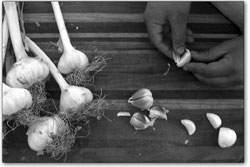|
|
||
|
Getting into garlic love by Chef Boy Ari As you walk the farmers’ market this midsummer, you might spot heads of freshly harvested garlic. Still attached to their stalks, with leaves and roots usually trimmed, they stand in buckets or lounge on tables. Don’t pass them by, because new garlic is a culinary opportunity that’s available only now. Unlike the cured garlic that you see in stores the rest of the year, new garlic has just been harvested, and is still metabolizing. It’s a living food, teeming with active enzymes and full of vitality. New garlic peels more easily than cured garlic, because the wrappers around each clove are still damp and fleshy, having yet to harden into dry paper. Emerging from their fleshy cocoons, the cloves are a bright, virginal white that seem to emanate light. They remind me of fresh scallops. Cooked, they turn translucent. Raw, some varieties of new garlic have a fiery, immediate heat, while others are soft. Either way, this fire is fun to flirt with, because unlike the fire of a hot pepper, a bite of garlic requires far less of a commitment and retreats quickly. Nibble on a raw clove while you’re eating just about anything savory, and explore the pleasures of co-munching. And if you don’t want the fire, the taste of new garlic can be mellowed with cooking. Declawed, those glowing chunks still stand out, a treat when they happen upon your tongue, sought after by those who mine for goodies at the bottom of the bowl. New garlic is more than flavoring. It’s a substantial component of your dish. It’s a vegetable, a centerpiece, as precious as bacon. One easy way to identify new garlic is that the bulbs are usually still attached to a long stem — unlike supermarket garlic, which is just a bulb with the stem cut off. Growers leave the stem attached to fresh garlic as part of the curing process; the stem serves as a conduit to wick water away from the bulb. Once cured, the stems are usually snipped off so that the bulbs take up less space for shipping and storing. By the way, gardeners: if you have garlic planted in your garden, it’s time to pull it out. And if you want to plant some garlic for next year, start thinking about it now. Garlic is planted in October, which means soon you will need to figure out where to plant it and prepare the ground accordingly. The best place to grow garlic is where your useless lawn currently resides – especially if it gets good sun. Garlic looks beautiful along your sidewalk all spring and half of summer, like a big field of lilies. Garlic is, in fact, a member of the lily family, drop-dead gorgeous if you let it flower (Which I don’t – makes the bulb smaller).
Why am I telling you all of this now? Well, when October rolls around, it will be too late to convert a piece of your lawn into garlic ground without a tragically heroic effort. But if you cover the ground right now with heavy-duty black or clear plastic (from the hardware or garden store), by the end of the summer the sod will be gone and the ground will have effortlessly converted itself to fertile worm shit, ideal for planting. By this time next year, you will have your own crop of new garlic. However you acquire your new garlic, you have many options for cooking it. I like a dish that presents the garlic, rather than just uses it. This means large pieces, even whole cloves – heck, even whole bulbs. You can go big with garlic, peeled or unpeeled, into just about anything: lasagna, soup, curry, and baked or broiled meat. When that soft garlic finds your mouth you will be glad. Here’s a simple new garlic summer stir-fry recipe that will serve four people. At the farmers’ market, buy 2 to 4 bulbs of new garlic, 1 to 2 pounds snap peas (the exact amount of peas depends on how many you eat on the way home) and a big head of cauliflower. Or buy whatever stir-fry vegetables you want: broccoli, zucchini, celery, peppers ... . Thinly slice your cloves of new garlic lengthwise, so they look like little guitar picks. Leave a few cloves whole. Fry the chopped pieces of a slice or two of bacon in 2 tablespoons sunflower oil over medium/high heat (skip the bacon if you must). As the bacon gets crispy, add some thinly sliced ginger and your whole garlic cloves. After about three minutes, add ¼ cup peanuts and stir vigilantly ’till they start to brown. Then add your sliced garlic, keeping the pan moist with cider vinegar, rice vinegar, or white wine. When the garlic slices start to turn translucent, add the cauliflower a minute before the peas, stirring constantly. As soon – and I mean, AS SOON – as the peas start to turn neon green, add ¼ cup oyster sauce, drop the heat to low, and stir. (Some veggies, like zucchini, like to be cooked longer than peas.) Sprinkle with minced raw garlic if you wish, or co-munch with a clove. Present your new garlic stir-fry with rice.
|
In this week's issue...
- May 15, 2025
- End of the trail
Despite tariff pause, Colorado bike company can’t hang on through supply chain chaos
- May 8, 2025
- Shared pain
Dismal trend highlights need to cut usage in Upper Basin, too
- April 24, 2025
- A tale of two bills
Nuclear gets all the hype, but optimizing infrastructure will have bigger impact


